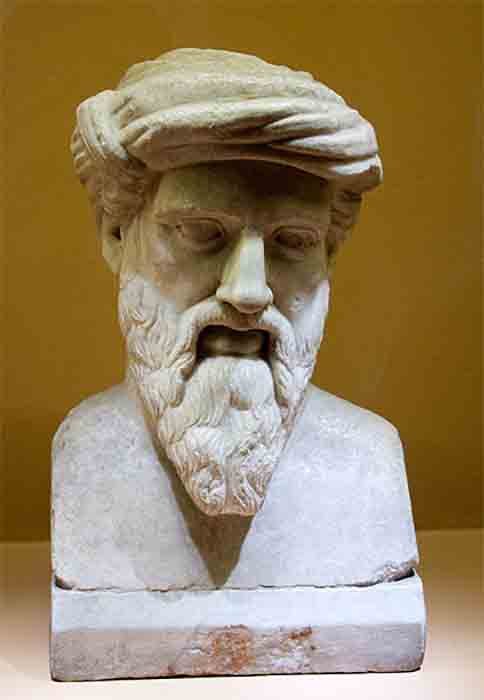On the Greek island of Samos there is a famous cave, named the Pythagoras Cave due to its association with the famous ancient Greek philosopher. Pythagoras is believed to have lived in the cave for a period of time, although is no concrete evidence, however, to support this. Today, the Pythagoras Cave is a popular tourist destination, and one of the main attractions of Samos.
The Cave and its Famous Association
The Pythagoras Cave is located on Mount Kerkis, on the western part of Samos. Mount Kerkis is an extinct volcano, and the second highest peak in the eastern Aegean. The Pythagoras Cave is actually more of a complex, consisting of two separate caves that are close to each other. The larger of the two caves was reputed to have been used by Pythagoras as a classroom, whereas the smaller one served as his living quarters. Apart from the differences in their size, the smaller cave has a flatter floor, making it more suitable for living.

Pythagoras (Unknown Author / Public Domain )
Pythagoras, the caves’ famous reputed occupant, was born around 570 BC, and was a native of Samos. He is perhaps best remembered for the Pythagorean theorem, although he may not even be the true author. It is instead speculated that the theorem might have been developed by the Pythagorean school, but subsequently attributed to their founder. Nevertheless, various other contributions to the development of Western thought and philosophy were made by Pythagoras (or attributed to him). In any case, the significance of Pythagoras, and the school he founded, is evident in the influence he had on the later works of Plato and Aristotle.
In spite of his importance, there is little information about Pythagoras from contemporary sources. Instead, the first fragmentary accounts of the philosopher’s life are from the 4 th century BC, about a century and a half after his death. It is thought that as a young man, Pythagoras travelled to Egypt and Babylon. This might help to explain the mystical elements of his teachings. Regardless of whether he travelled to these foreign lands or not, he eventually settled and began to teach in Samos. At this point in his life, we are told Pythagoras decided to leave human society and live in a cave.
Pythagoras the Hermit
According to one version of the story, Pythagoras ended up living in a cave as he was trying to hide from Polycrates, the tyrant who was ruling Samos at the time. According to this story, Polycrates had accused Pythagoras of trying to corrupt the young people of Samos with his teachings, causing Pythagoras to flee for his life.
Another account states that Pythagoras himself did not approve of Polycrates’ form of government, and was worried about what he might do if he encountered the tyrant. Therefore, to avoid this he willingly went into exile.
A third account states that instead of Polycrates, it was a fellow philosopher who caused Pythagoras to live in a cave. Anaximander of Miletus , who disapproved of Pythagoras’ teachings, accused him of being a troublemaker and infidel, and stirred up the Samians against him. Consequently, Pythagoras may have been forced to flee to the cave.

Pythagoras Cave on Mount Kerkis, Samos (Tomisti, CC BY-SA 4.0 )
There is a final, more peaceful suggestion whereby Pythagoras was not forced to live in the cave, but chose to do so, as it was an ideal place to meditate. Although all these accounts differ, on one fact they all agree: Pythagoras chose to live in a cave on Samos, and it is this cave on Mount Kerkis that he is believed to have chosen.
Pythagoras after the Cave
Around 532 BC, Pythagoras left Samos altogether for southern Italy, and established a school at Croton. Apparently, the philosopher left the island to finally escape from Polycrates’s tyranny. Although Pythagoras was initially welcomed at Croton, public opinion was slowly turning against him. Anti-Pythagoras sentiments grew so strong that in 510 BC, the philosopher fled to Metapontum, where he lived until his death around 495 BC.
Today, the Pythagoras Cave is open to visitors. In the smaller cave, where Pythagoras is said to have lived, there are three rooms, though only two of them can be visited. There is also a spring in the Pythagoras Cave, from where the ancient Greek philosopher is believed to have obtained his drinking water. Apart from the caves, there are two chapels on Mount Kerkis that can be visited. The first of these is dedicated to Saint John , whilst the second, called Panagia Sarantaskaliotissa, is dedicated to the Virgin Mary. Lastly, the site offers visitors a panoramic view of the valley and sea below it.
Top image: Pythagoras is known to have lived in a cave. Source: JIT / Adobe Stock.
By Wu Mingren
Related posts:
Views: 0
 RSS Feed
RSS Feed















 May 15th, 2021
May 15th, 2021  Awake Goy
Awake Goy  Posted in
Posted in  Tags:
Tags: 
















